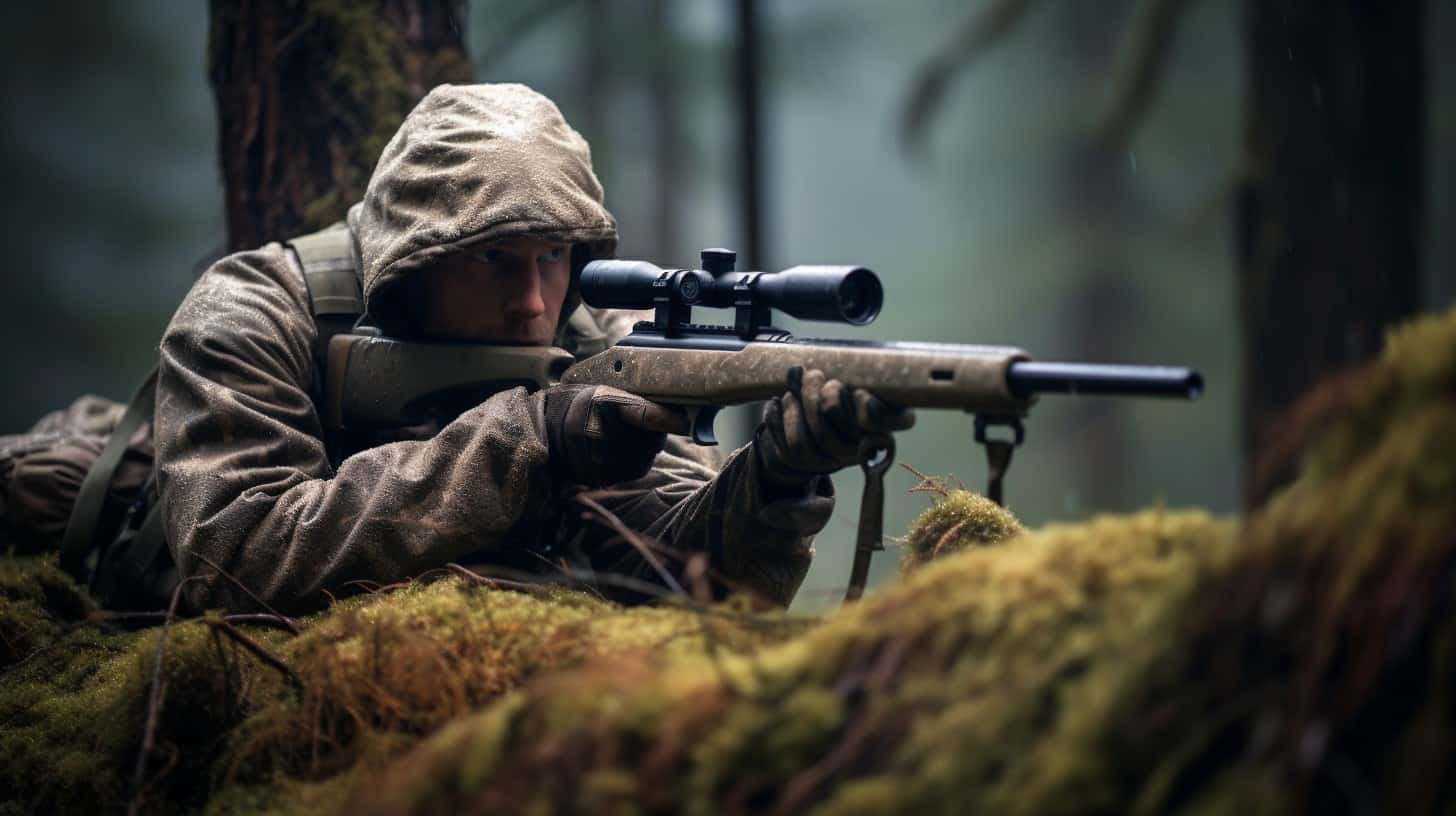Navigating the sea of rifle scopes is a bit like threading a needle in dim light—it requires patience and precision. As a fellow enthusiast who has paced the aisles of sporting goods stores and scoured numerous rifle optic reviews, I understand the delicate balance between cost and quality all too well.
Navigating the myriad of scopes on the market today can feel overwhelming. Doing your homework by reading rifle optic reviews and understanding the basics of what makes a quality scope are key steps before making this critical investment.
Countless hours have been devoted to unearthing every nugget of wisdom on this topic, just for you. Let me be your guide as we hone in on that ideal price-performance ratio that won’t leave your wallet empty.
Get ready to zero in; your perfect scope is closer than you think!
Key Takeaways
When buying a rifle scope, think about how you’ll use it. Short-range scopes should be quick and not too zoomed in. Medium-range scopes need better lenses for clearer views further out. Long-range scopes require high magnification and large lenses to see far.
Quality glass is worth spending on because it lets you shoot better by making things clear, even when far away or in low light. But remember that a big lens can make your scope heavy.
You can find good scopes at different prices. Sometimes, it’s smart to spend half as much as your gun costs on a scope. This means if I have an expensive rifle, I should invest in a good scope too.
Turrets adjust where shots go, while the right eye relief keeps my face safe from the gun’s kickback.
Features like first or second focal plane reticles and MOA or MRAD adjustments matter for hitting targets just right.
Table of Contents
Understanding Rifle Scope Basics
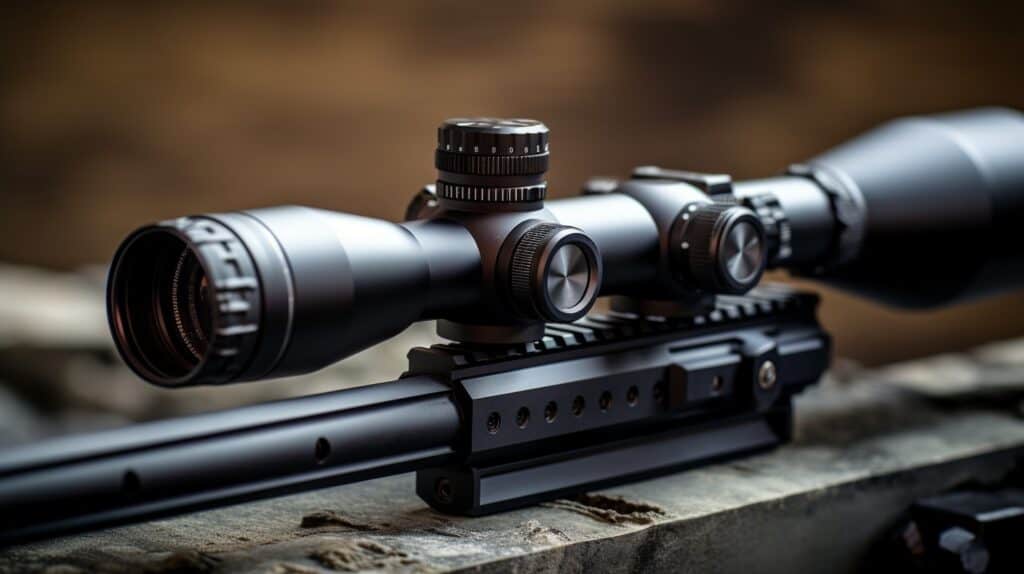
Diving into the world of rifle scopes can feel like navigating a maze with its own lingo and rules – but fear not, once we grasp the essentials, choosing the right optic becomes a clear shot.
It’s about more than just slapping any scope on your firearm; understanding how magnification, lens size, and other features affect your shooting experience is fundamental to hitting that bullseye every time.
What is a Riflescope?
A riflescope is like a special kind of telescope for your rifle. It helps you see far away things up close so you can aim better. With a good scope, it’s easier to hit where you’re looking.
Think about using binoculars to spot birds in the trees; now imagine that on your gun, but with a crosshair to show exactly where your bullet will go.
Good scopes have really clear glass and special layers on the lens that make what you see brighter and sharper. They also let you adjust for how high or low, and left or right your shots need to go.
Today’s scopes are even tougher and more useful than old ones because they work well up close and at mid-distances too.
The Importance of Magnification
Magnification lets you see far-away targets like they’re up close. If you want to hit a target that’s way off, turning up the zoom helps. But there’s a catch called tunneling. That’s when too much magnification makes your view look like it’s through a tube, which can mess with your aim and experience.
You need just the right amount of zoom to match what you’re shooting at. Get this part wrong and even aiming perfectly won’t guarantee a good shot. You’ll find out more about lenses next, which is super important for clear views and sharpshooting.
Objective Lens Significance
Just as magnification pulls your target closer, the objective lens decides how clear and bright that view will be. The bigger the lens, the more light gets in. This means a brighter picture when you’re aiming.
It’s key to get a scope with a good-sized lens if you want to shoot well, especially in low light like dawn or dusk.
I’ve learned that investing in quality here matters a lot. A high-quality, objective lens can make all the difference for hunters and shooters wanting sharp images at any range. Sure, big lenses on top scopes might cost more, but they help me hit my mark every time.
I don’t go cheap on this part because fuzzy sights are no good when it’s time to take that important shot.
Rifle Scope Optics Explained
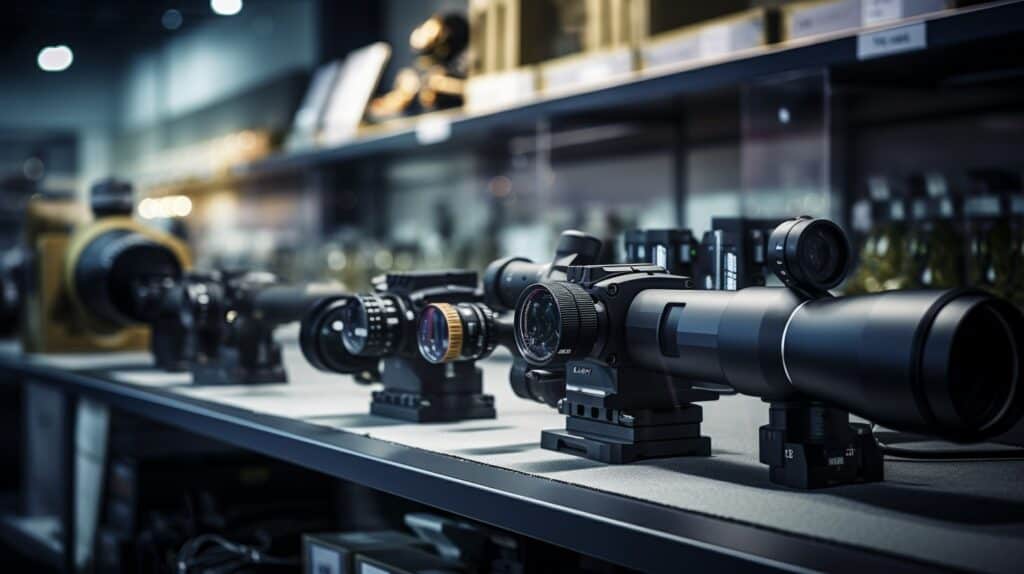
Diving into the world of rifle scope optics is like peering through a window to sharpen skills and enhanced precision. Let’s unravel the complexities that transform a good shot into an impeccable one, focusing on how these vital components can elevate your shooting experience.
Fixed vs. Variable Scopes
I like to think about fixed and variable scopes like I do my shoes. A fixed scope is like that reliable pair of boots – solid and trustworthy, but you can’t really change how they fit.
It’s got one magnification level. This is perfect if I know exactly what distance I’ll be shooting at.
On the other hand, a variable scope offers more choices, like sneakers with adjustable laces. You can zoom in or out because it has different magnification levels. For me, this means versatility for different shooting ranges and situations.
Whether hunting or at the range, having options to adjust my view is super handy!
Magnification: Finding Your Sweet Spot
Picking the right magnification for your rifle scope is like finding the perfect pair of shoes; it’s got to fit just right for your shooting style. Too much zoom can make short-range shots tough, and not enough can leave you squinting at far-off targets.
You want that sweet spot where things look clear and steady, whether you’re aiming close up or way out there. Many folks agree it’s smart to match your magnification level with what you’re actually going to shoot at most often.
You get scopes that don’t change their zoom – these are fixed scopes. They’re usually more rugged because they’ve got fewer moving parts inside. Then there are variable scopes that let you adjust the zoom in and out, giving you flexibility if your shooting ranges vary a lot.
Keep in mind the kind of distances you’ll be firing over before deciding on which type suits you best. It’s all about making sure the scope works as hard as you do when lining up those shots.
Now, let’s move on to talk about how big your objective lens needs to be for top-notch visibility.
Objective Lens: Determining the Necessary Diameter
I know that picking the right objective lens size for your riflescope matters a lot. The objective lens is what lets light into your scope, so if you want a bright and clear view, the diameter needs to be big enough.
But here’s the catch: bigger isn’t always better. A huge lens can make your scope bulky and hard to handle.
For most of us shooters, an objective lens around 42 mm or less hits the sweet spot – it gives you enough brightness without weighing down your rifle. If you’re aiming close-up, like under 100 yards, go with something under 28MM; it’s quick on target and keeps things light.
And for those medium-range shots up to 200 yards? Choose between 30-44MM on your magnification from 5-8X so everything looks sharp without too much bulk. Remember this: balance is key for a good shot!
The Role of Lens Coatings
Lens coatings are a big deal in rifle scopes. They make your view clearer and sharper by cutting down glare and letting more light reach your eye. Imagine you’re out hunting early in the morning or late in the evening; that’s when good coatings can really show their worth, making things bright enough to see.
These coatings also protect the lens from scratches and dirt which means your scope lasts longer. This is important because we all want gear that stands up to what nature throws at it, right? Now, better coatings usually mean a higher price tag, but they’re worth it for clear shots and durability.
We’ve got to get the most bang for our buck!
Alright, let’s talk about deciphering field of view next.
Deciphering Field of View
Good coatings on your scope’s lens help you see clearer, but what about seeing wider? That’s where field of view (FOV) comes in. It shows how much of the world you can see through your scope at a glance, usually measured in feet over 100 yards.
A wide FOV is super handy when you’re watching for moving targets or need to keep an eye on big areas.
Think of it like this: with a broad field of view, finding and tracking game gets easier because more stuff fits into the picture without moving your rifle around too much. But as magnification goes up, FOV shrinks down.
So if close-up detail matters most to you for those far-off shots, be ready to swap some width in view for that zoomed-in clarity. You’ve got to balance between seeing far and keeping things wide depending on what and where you’re shooting.
Scope Reticles and Adjustment Systems
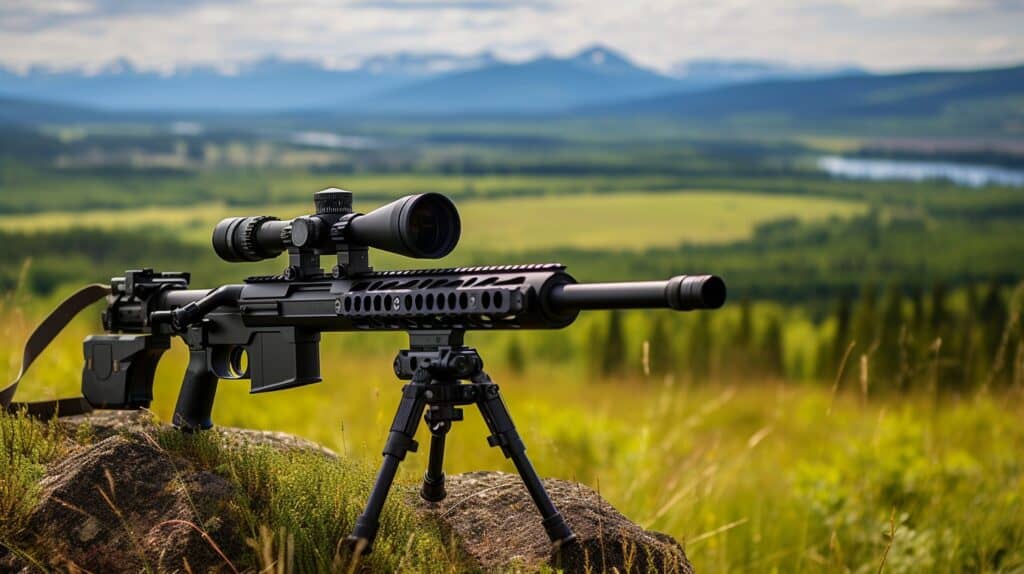
Navigating the myriad of reticles and adjustment systems can be like deciphering an encrypted message – but fear not! Unlocking the secrets behind MOA, MRAD, and whether to go first or second focal plane will have you shooting with precision in no time.
Exploring Scope Reticles
I like to think of scope reticles as the heart of a rifle scope. They help you aim and tell you where your bullet should hit. There are different kinds, like crosshairs, duplex reticle, mil-dot, and more fancy ones with dots or lines that can help you guess distance or wind speed.
Each type has its own job for different shooting styles.
If I am aiming at something far away, I might want a mil-dot reticle to figure out how far it is. But if my target is moving fast, maybe a simple crosshair works better because it’s quick and easy to see.
And now scopes come with cool things like reticle illumination, which lets me see my point of aim better in low light.
The choice really matters because some shooters need those extra marks on their reticles for making long shots count. Others may find them too busy and just want something plain so they don’t get distracted.
It all depends on what feels right for each person.
After picking the perfect reticle, the next step is understanding MOA versus MRAD adjustments – but that’s another story waiting to be told!
MOA vs. MRAD: Making the Right Choice
After looking into the different reticles, let’s talk about MOA and MRAD. These two are ways to measure how you can adjust your aim on a scope. Think of them as measuring sticks for your shots.
Most people in the US use MOA because it’s what they know best. Each click moves the shot a tiny bit at 100 yards.
MRAD is liked by shooters around the world and uses meters to measure. One benefit is that it can make thinking in metric units easier if that’s what you’re used to. Your choice between MOA or MRAD should match what feels right for you and makes sense with how you shoot.
First Focal Plane vs. Second Focal Plane
Choosing between MOA and MRAD is just part of getting the right scope. You also need to think about if a first focal plane (FFP) or second focal plane (SFP) suits your shooting needs better.
FFP scopes have reticles that grow or shrink when you change magnification. This means at high power, the marks on the reticle are super accurate for long-range shots. They’re great if you shoot far away targets a lot.
But, these fancy FFP scopes cost more than SFP ones because they are harder to make. If you mostly shoot closer targets, an SFP scope might work better for you. The reticle size in these stays the same no matter how much you zoom in or out, making them simpler to use at short or medium distances.
Plus, they won’t hit your wallet as hard as an FFP would!
Turrets and Eye Relief
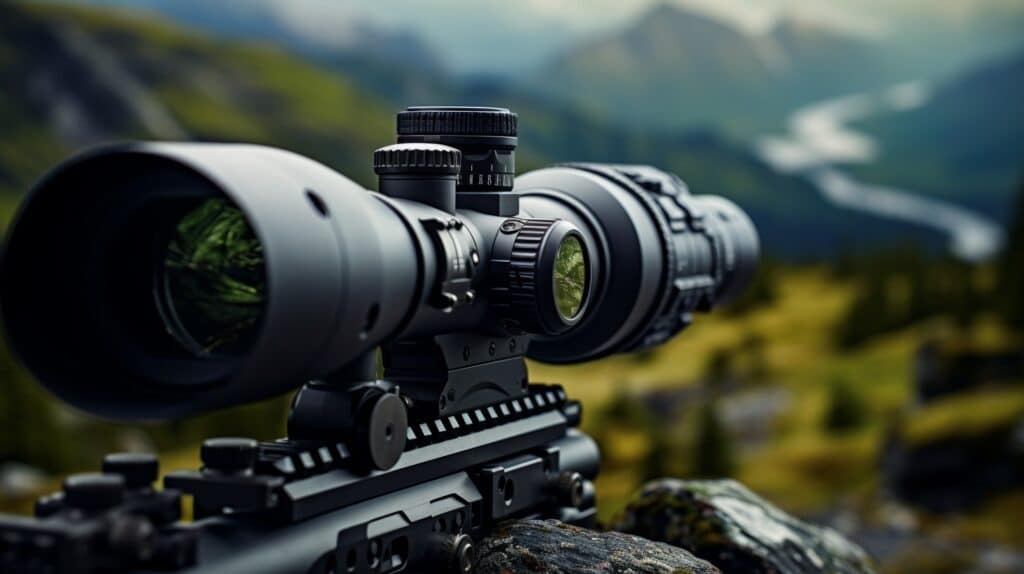
5. Turrets and Eye Relief: Mastering the precise adjustments of windage and elevation turrets is essential, just like ensuring proper eye relief to avoid scope bite—dive in to learn how these features can significantly enhance your shooting experience.
The Function of Windage and Elevation Turrets
Windage and elevation turrets on my rifle scope are like the steering wheel of a car. They help me make sure my shots hit right where I want them to. The windage turret moves my aim left or right, which is handy when the wind tries to push my bullet off course.
The elevation turret lets me adjust up or down, so if I’m shooting at something far away, I can aim higher and make sure the bullet drops just enough to hit the target.
These little knobs are super important for fine-tuning my aim. And guess what? Most new scopes come ready to use straight from the factory! But even with that, knowing how these turrets work means I can always stay on top of my shooting game, no matter where I am or what conditions I face.
Eye Relief: Ensuring Comfort and Safety
Turrets help you aim better, but eye relief keeps you safe. Eye relief means how far your eye is from the scope to see well and not get hurt by recoil. You need the right distance to protect your eyes and make sure shooting is comfortable.
Each scope has its own eye relief, so check it before you buy.
Make sure your scope fits both your gun and how you shoot. A good fit means no black rings when you look through your scope and no worry about getting hit in the face. Safe shooting is happy shooting!
Parallax Adjustment and Its Importance
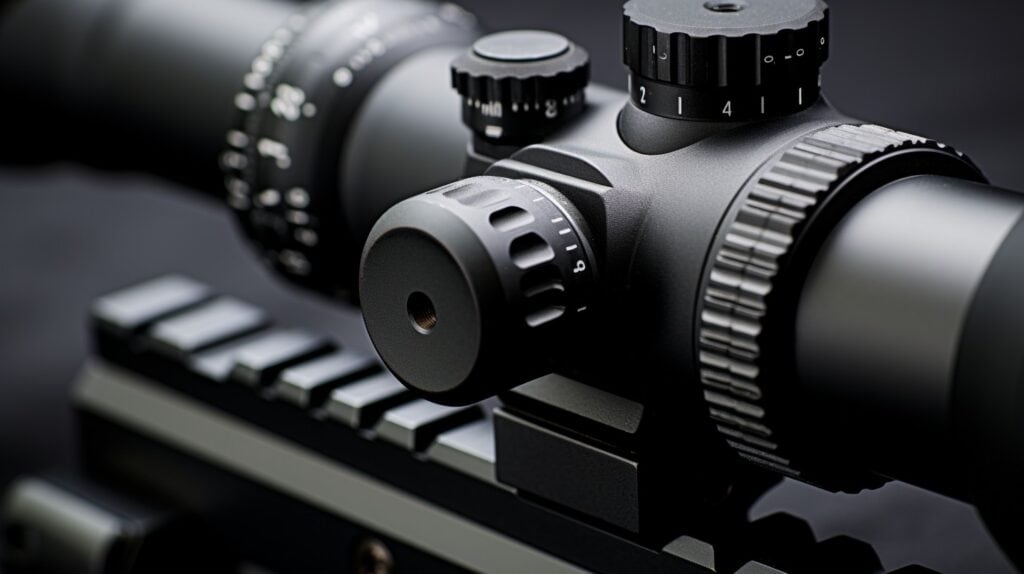
Understanding the intricacies of parallax adjustment is crucial for sharpshooting accuracy, as it counters potential reticle shifts that could throw off your shot; dive deeper to master this game-changing skill and elevate your precision on the range.
Understanding Parallax in Rifle Scopes
I always make sure my rifle scope is on point because parallax can mess up a good shot. Think of parallax like this: It’s what happens when the image of your target doesn’t line up right inside your scope.
If you move your head around and the cross-hairs seem to dance around the bullseye, that’s parallax being sneaky.
To stop that from happening, scopes have this cool thing called a parallax adjustment. Use it to match how far away your target is, and boom—no more jumpy cross-hairs. Just remember to set those hairs dead center at zero-distance; it keeps things super accurate.
Whether it’s factory-set or I need to tweak it myself, getting rid of parallax means my shots are clear and right where I want them every time.
Choosing a Parallax Correction Method
Now that we’ve got a grip on what parallax is in rifle scopes, let’s talk about fixing it. Some scopes come with built-in ways to adjust for parallax. Often, you’ll see a knob on the side or a ring by the objective lens that you can turn to make your target clear and free from shift when you move your head.
Choosing how to correct parallax depends on what kind of shooting you do. If your shots are usually at different distances, like hunting or tactical scenarios, look for a scope with adjustable parallax settings.
This way, you can tweak it on the fly for each shot. For those who shoot at set ranges, like competition shooters, a fixed parallax setting scoped to your usual distance works fine and saves time during shooting.
Selecting a Rifle Scope Based on Shooting Range
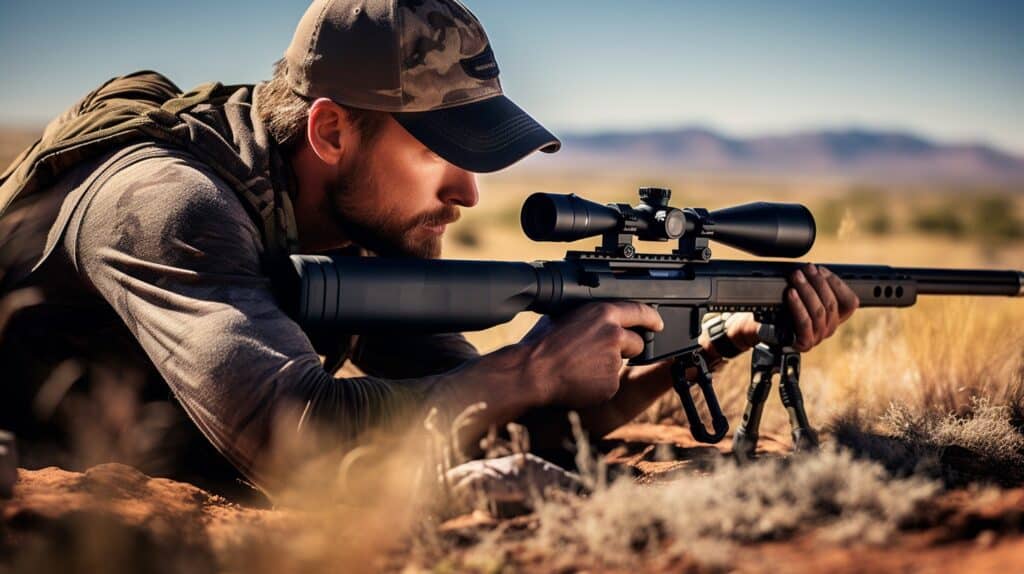
Choosing the right rifle scope for your shooting range can dramatically improve your accuracy; whether you’re aiming at close-quarters targets or engaging in long-distance precision work – find out how to pinpoint the perfect optic for your marksmanship needs.
Short-Range Shooting: Optics and Recommendations
I know how exciting short-range shooting can be. The right scope makes all the difference.
- Short-range scopes are perfect for quick action and fast targets. They usually have 1-4X magnification.
- Look for an objective lens size of 28MM or less; it’s ideal for close-up shots.
- Red dot, holographic, and reflex sights give you speed. They help you aim quickly.
- A reflex sight is simple to use. It gives a clear view and works great even if your eye isn’t perfectly lined up.
- For short-range, I recommend the Primary Arms Classic Series 1-4×24. It’s reliable and affordable.
- The Barska 1 – 4×28 IR Hunting Scope could also be a good fit. It has illuminated reticles, which help in low light.
- Try the UTG 3 – 9X32 if you want versatility. It’s good for both short and a little longer shots.
- Don’t miss the Bushnell Trophy TRS-25; it’s small but mighty in clarity and toughness.
- If you want top tech, look at EOTech EXPS2. Its holographic sight is top-notch.
- Vortex Optics Sparc is another solid choice. Many shooters love its durability and clear glass.
Medium-Range Shooting: Features and Scope Suggestions
Moving from the close quarters of short-range shooting, medium-range demands a different set of features in a rifle scope. It’s all about balance – finding the right mix between power and practicality. Here are some must-haves for medium-range optics and my top picks for scopes:
- Look for variable scopes with a magnification range that starts low, like 3x, and goes up to at least 9x or more. This allows for quick aiming at closer targets while still being able to zoom in for further shots.
- The ideal objective lens diameter is around 40-42mm. It provides a clear view without making the scope too big or heavy.
- Lens coatings matter even more here. Go for fully multi-coated lenses as they boost light transmission; critical when you’re aiming at targets farther away.
- A reticle that suits medium distances is key. I prefer MOA reticles as they make it easier to adjust shots without needing complex math.
- First focal plane (FFP) vs second focal plane (SFP) becomes important here. FFP reticles size up with magnification, keeping holdovers constant, which can be useful as your target distance changes.
- Scopes with good eye relief will keep your brow safe during recoil – look for something around 3.5 inches or more.
- Parallax adjustment can start to play a role at these distances; select a scope that offers this feature if you’re going past 100 yards often.
Long-Range Precision: Best Practices and Top Scopes
Hitting a target from far away is tough. You need a good scope to do it right. Here’s what you should know about long-range precision shooting and the scopes that help you nail those distant shots:
- Pick a high-quality scope with great glass: This makes sure you see far and clear. Look for scopes with extra-low dispersion (ED) glass to keep the image sharp.
- Go for higher magnification: For long ranges, more than 10x magnification helps, but remember, the higher you go, more light and steadiness you’ll need.
- Choose large objective lenses: A big objective lens brings in more light. This is key when shooting at dawn or dusk.
- Consider first focal plane (FFP) reticles for precise shots: With FFP, the scale of your reticle changes as you zoom in or out. This keeps your aiming points correct, no matter the magnification.
- Use turrets for accurate adjustments: Good turrets let you adjust for windage and elevation without fuss. They should be reliable and easy to read.
- Look at scopes from trusted brands like Leupold, Vortex, and Nightforce. These companies make some of the best long-range optics out there.
- Check out the Vortex Razor HD series for strong performance and durability.
- Try the Leupold Mark 5HD if you want something battle-tested by snipers.
- The Nightforce NXS is another favorite among long-range shooters for its rugged build.
- Keep your scope clean with proper gun cleaning tools; use a gentle cloth and cleaner made for lenses.
- Store your scope safely when not in use; avoid places that are very hot or cold.
- Spend time at the range to get familiar with your equipment.
- Test different settings on your scope during practice to find what works best for you.
Investing in a Quality Rifle Scope
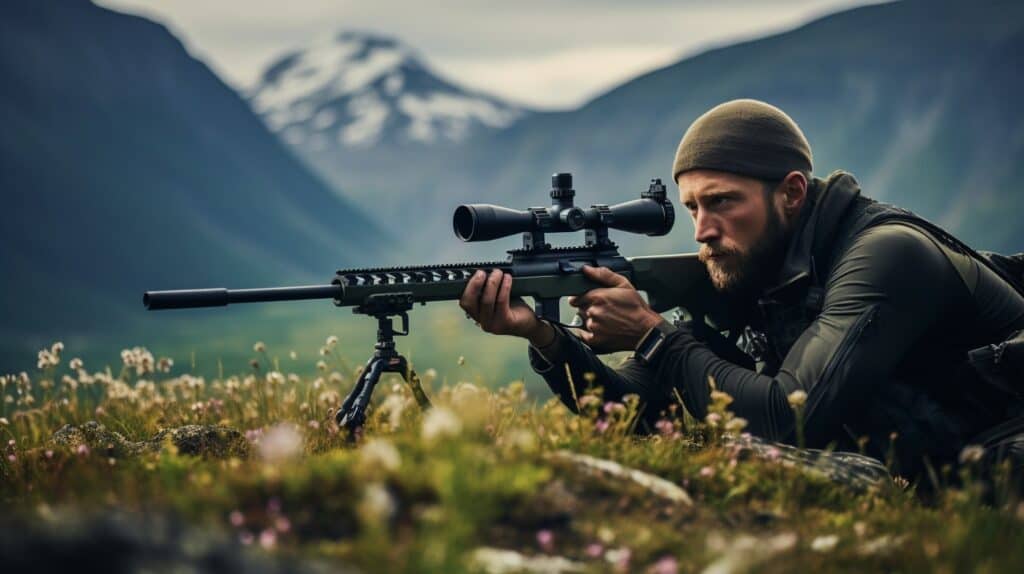
Investing in a quality rifle scope is like putting premium fuel in a high-performance vehicle; it’s not just about clarity and precision, but ensuring your shooting experience matches the investment you’ve made in your firearm.
We often hear that ‘you get what you pay for,’ and nowhere does this ring truer than with the glass sitting atop your rifle – skimping could mean missing not just the target, but the whole point of a fulfilling shoot.
The True Cost of Quality
Good glass and tough scopes cost more, but they’re worth it. We all get that paying a bit extra can mean the difference between okay and awesome. But here’s the thing: just because it’s pricey doesn’t mean it’s the best.
Some cheaper rifle optics are getting really good thanks to better technology in making them. You want clear views and a scope that lasts? Spend enough, but don’t think you have to break the bank.
Consider stuff like how well the scope holds its zero after lots of shots or if it can handle being knocked around a bit without slipping off target. That’s where your money should go – into repeatability and durability.
A great rifle paired with a poor scope won’t do you any favors, so balance spending on quality without going overboard. Now, let me tell you about why skimping on your optic could end up costing you more in the long run.
Why You Can’t Afford to Skimp on a Scope
Saving money on a scope might seem smart, but it can hurt your shooting. Cheap scopes often have blurry images and weak builds. You end up with a tool that doesn’t help you aim well or last long.
I’ve learned through experience that if you buy a better scope, even if it costs more, it pays off. Good glass and coatings make for clear views and accurate shots.
A pricier scope can seem like too much when looking at the sticker price alone. But think about this: Over time, having to replace cheaper scopes adds up in cost anyway! Also, imagine missing an important shot because the optic failed you—that’s costly in its own way! So invest in quality now; your future self will thank you for those crisp images and reliable performance every time you line up a shot.
The Balance of Cost and Performance
Getting the right balance between how much you spend and what you get in a rifle scope matters. You don’t need to match your rifle’s price tag, but remember, going too cheap could hurt your shooting.
I’ve learned that good glass can make a world of difference. Even though some high-priced scopes might not seem better than more affordable options, it’s all about finding what works best for you.
Investing wisely means looking at your own needs first. A pricey scope with features I’ll never use doesn’t do me any good. It’s smarter to pick optics based on what I plan to do with it rather than just the cost or brand name alone.
This way, performance meets my expectations without emptying my wallet.
Mounting and Maintaining Your Rifle Scope
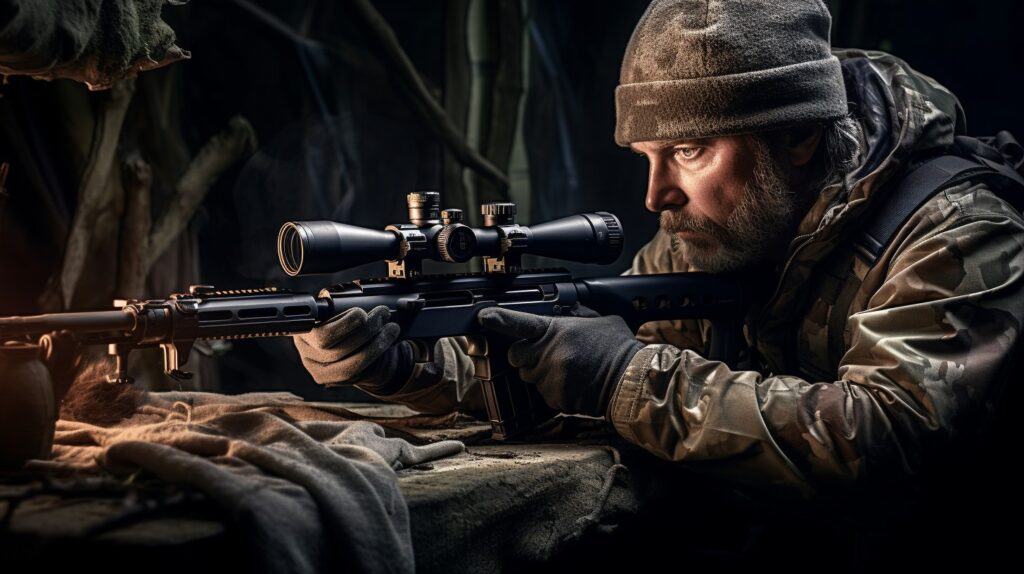
Mounting your rifle scope correctly is just as crucial as the scope itself; a shaky foundation can render even the top-tier optics ineffective. I’ll guide you through securing that rock-solid base and unveil maintenance hacks to keep your scope in prime condition, ensuring precision with every shot.
Proper Scope Mounting Techniques
I know how important it is to mount a rifle scope the right way. A well-mounted scope keeps your shots accurate and your eyes safe.
- Check your gear first. Make sure you have the right tools for the job, like a torque wrench, screwdriver, and gun cleaning mats to protect your rifle.
- Clean everything. Use a DIY gun-cleaning approach or wipes to clean the mounting area. No dirt means no problems later.
- Place the scope’s base on the rifle. Tighten it just enough so it won’t move when you’re working with it.
- Next, set up the rings. Put them lightly on the base without fully tightening so you can adjust as needed.
- Carefully place the scope in the rings. Keep an eye on alignments and make sure the reticle is level.
- Adjust for proper eye relief. Move the scope back or forward until you see a full view without dark edges around it.
- Start tightening screws evenly. Alternate between sides to keep pressure balanced and avoid damaging your scope.
- Use a torque wrench if possible. Follow manufacturer recommendations for how much force to apply so everything stays snug but not too tight.
- Double-check reticle alignment once more before giving all screws one last gentle tighten.
- Zero in your rifle at this point; follow steps to make sure your shots line up with where you aim.
Zeroing Your Scope: A Step-by-Step Guide
Now that your scope is mounted, it’s time to make sure it’s zeroed for accurate shots. Zeroing a scope means lining up the crosshairs with where the bullet will hit at a certain distance. Here’s how you can zero your rifle scope step by step:
- Gather Supplies: You’ll need a gun vise or sandbags to hold your rifle steady, targets, ammunition, and a shooting range.
- Set Up Your Target: Place your target at the desired distance. For most rifles, this will be 100 yards.
- Get Comfortable: Make sure you’re in a stable position and take three careful shots at the target center.
- Check Your Shots: Look where your bullets hit. Are they too high, too low, or off to one side?
- Adjust Turrets: Use windage and elevation turrets on your scope to adjust the crosshairs towards where the shots hit.
- Windage Adjustment: Turn the windage turret right if shots are left of center; turn it left if they’re right of center.
- Elevation Adjustment: Turn the elevation turret up if shots are low; turn it down if they’re high.
- Shoot Again: Fire another three shots to see how well your adjustments worked.
- Keep Making Small Adjustments until your shot group centers on the bullseye of your target.
- Confirm Zero: Once centered, take several more shots to ensure consistency.
Cleaning and Maintenance Tips for Longevity
I take care of my rifle scope so it can last a long time and work well. A clean scope helps me shoot better and keeps my gear in top shape.
- Always start with the outside. Use a soft cloth to wipe down the body of the scope. This removes dust and dirt that can scratch the surface.
- Use lens caps when you’re not shooting. They protect the lenses from scratches and keep them clean.
- Get a lens brush or air blower. Gently remove debris from the lens without touching it. This stops oils from your skin getting on the lens.
- Lens cleaning solution is helpful. Put some on a microfiber cloth, not directly on the glass. Wipe in a circular motion to avoid streaks.
- Check all screws and mounts regularly. Tighten them if they get loose to make sure your scope stays stable.
- After every use, do a quick check-up. Look for any damage or changes in how the scope works.
- Store your rifle and scope in a cool, dry place. Too much heat or dampness can hurt them over time.
- Zeroing in should be done often, especially if you bump or drop your scope.
Final Thoughts on Rifle Scope Investment
As we zero in on the importance of investing wisely in a rifle scope, remember that choosing the right optics is not just about spending money; it’s about enhancing your precision and overall shooting experience—join me as I delve into making an informed decision for your next investment.
Making an Informed Purchase
I take my gear seriously, and I know you do too. Choosing the right rifle scope is more than just looking at price tags; it’s about understanding what makes a good investment for your shooting needs.
Think about it this way: if a scope costs less now but doesn’t hold up in the field, you’re not saving money; you’re wasting it. Investing up to half of your rifle’s cost into a quality scope isn’t just advice—it’s smart planning for top performance and reliability.
Let’s get real—none of us want to regret our choices out there when it counts. So we check that warranty coverage carefully because those parts are bound to move and shake with use.
A solid warranty means peace of mind in rough conditions where cheaper scopes might let us down. Making an informed purchase means balancing cost against features, durability against performance, so that every shot counts.
Now let’s talk turrets and eye relief next..
Investing in the Right Tools for Success
Having made a smart choice with your purchase, it’s vital to pair that decision with the right tools for success. Think of your rifle scope as a key part of your shooting gear. You wouldn’t cut corners on the quality of your firearm, so investing in a reliable scope is just as important.
High-quality glass and coatings make a huge difference in clarity and precision, which you’ll notice every time you aim at your target.
Getting the best tools means not only buying a good scope but also keeping it sharp. Clean lenses with care using proper gun cleaning rods and maintain calibration with correct adjustments.
Don’t let price fool you; higher cost doesn’t always mean better quality. Research rifle optic reviews and find scopes that have the features you need without breaking the bank. Remember, success in shooting comes from both skill and having the right equipment working together perfectly.
FAQs About Rifle Scopes
How much should I spend on a rifle scope?
You can find good rifle scopes at different prices, but typically, you might pay anywhere from $100 to over $1000 depending on the quality and features like precision for long-range shooting.
Does the price change if I want a scope for a specific gun, like in “Extraction 2” or “Jason Bourne”?
Yes, some guns used by characters like Tyler Rake or Jason Bourne may need special scopes, which could cost more because of unique requirements such as minute-of-angle (MOA) adjustments or long-range accuracy.
What is MOA, and does it affect how much I should budget for a scope?
Minute of Angle (MOA) helps with aiming precisely; higher-quality scopes with better MOA adjustment could cost more but help shooters hit targets accurately.
Are there cheaper options for sights besides traditional riflescopes?
Yes, red dot sights and low-power variable optics are often less expensive alternatives that work well for quick aiming and closer distances.
Do I need to spend extra money on maintenance for my riflescope?
Keeping your riflescope maintained is important but doesn’t have to be costly; regular cleaning and care are usually enough unless it needs repair due to damage.
Will buying a more expensive rifle scope make me shoot better?
Not always; while pricier scopes offer more features like clearer magnified views or parallax correction, which can aid precision shooters, practicing proper technique is also crucial to improving shooting skills.

